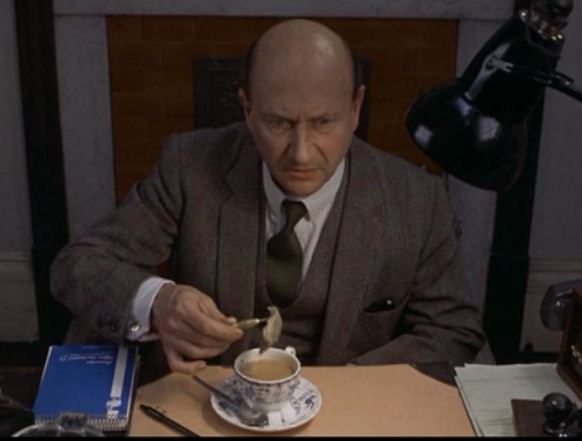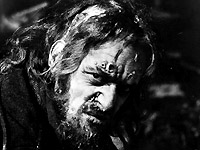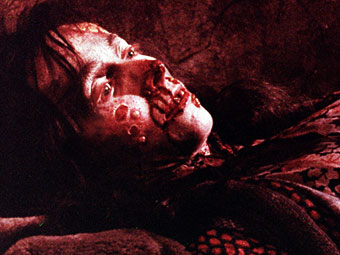As I intimated in Ghouls Underground, I’ve been meaning to write about Death Line (known charmingly as Raw Meat in the US) for a while now and since 2013 is the 150th anniversary of the opening of the London Underground it seemed like a good idea to revisit one of my favourite cult movies. Gary Sherman’s 1973 film is one that still stands out as a true original and despite several films that have centred around horrific events in the underground (like Chris Smith’s Creep [2004] and Ryûhei Kitamura’s Midnight Meat Train [2008]) you are unlikely to see anything else that comes close to capturing the unique atmosphere of this largely unheralded addition to 1970s British horror.
The story of strange disappearances, murder and cannibalism on the London Underground is one of horror cinema’s genuine oddities and that such lurid themes are used to shape such a sombre and mournful film is testament to some telling contributions from the actors and filmmakers responsible. Director and co-writer Gary Sherman brings an outsider’s (ie: American) eye to the grubby context of 1970s London but also manages to expertly capture the quirky nuances of the capital’s labouring denizens.  From the very outset, as the brassy theme tune is belted out over images of an unsavoury, bowler-hatted civil servant as he emerges from a Soho nightclub, we become immersed in the fractious and class-conscious world of 1970s Britain that some of us remember so well. The subsequent disappearance and murder of James Manfred OBE – last seen alive slumped on the steps of Russell Square tube station – sparks off a series of investigations that exposes the injustices of a class-ridden culture that permeates both past and present.
From the very outset, as the brassy theme tune is belted out over images of an unsavoury, bowler-hatted civil servant as he emerges from a Soho nightclub, we become immersed in the fractious and class-conscious world of 1970s Britain that some of us remember so well. The subsequent disappearance and murder of James Manfred OBE – last seen alive slumped on the steps of Russell Square tube station – sparks off a series of investigations that exposes the injustices of a class-ridden culture that permeates both past and present.
The hero of the piece is played beautifully by Donald Pleasence and his performance as the sardonic, tea-swigging Inspector Calhoun is amongst the very best of a quirky and distinguished career.  His beleaguered and often testy inspector is brought effortlessly to life and this role is the equal of Pleasence’s’ other great cult performances as Doc Tydon in Ted Kotcheff’s outback nightmare Wake in Fright (1971) (a film that like Death Line defies easy categorisation) and his unforgettable Dr. Loomis in John Carpenter’s Halloween (1978). Pleasence is aided immensely by some of the supporting cast, most notably by Norman Rossington as his loyal deputy Sergeant Rogers and memorably (although fleetingly) by special guest star Christopher Lee as MI5 man Stratton-Villiers.
His beleaguered and often testy inspector is brought effortlessly to life and this role is the equal of Pleasence’s’ other great cult performances as Doc Tydon in Ted Kotcheff’s outback nightmare Wake in Fright (1971) (a film that like Death Line defies easy categorisation) and his unforgettable Dr. Loomis in John Carpenter’s Halloween (1978). Pleasence is aided immensely by some of the supporting cast, most notably by Norman Rossington as his loyal deputy Sergeant Rogers and memorably (although fleetingly) by special guest star Christopher Lee as MI5 man Stratton-Villiers.  The short battle of wits between Pleasence and Lee crackles with energy and tension, emphasising the poisonous influence of class and self-interest that shapes much of the message of the film. Inspector Calhoun is told in no uncertain terms to ‘run along’ back to his ‘manor’ with its workaday villains and petty criminals and to forget about the fate of more lofty governmental types, however dubious their nefarious night-time activities may be.
The short battle of wits between Pleasence and Lee crackles with energy and tension, emphasising the poisonous influence of class and self-interest that shapes much of the message of the film. Inspector Calhoun is told in no uncertain terms to ‘run along’ back to his ‘manor’ with its workaday villains and petty criminals and to forget about the fate of more lofty governmental types, however dubious their nefarious night-time activities may be.
The later discovery of the last remnant of a tribe of abandoned underground workers whose cannibalistic tendencies have done for Manfred and other poor unfortunates pulls together the class crimes of the past to sharp effect in the present. Alongside images of the remnants of decayed swinging London and the sleepy, tea-fuelled procedural work of the metropolitan detectives, the film shows the bleak and mournful existence of ‘the man’, an unnamed subterranean dweller whose tunnelling ancestors were the victims of a tragic cave-in only to be abandoned by the callous disregard of their Victorian corporate masters.  Hugh Armstrong’s portrayal of ‘the man’ is played in heavy disguise (he’s both hairy and covered in unsightly sores) and though he has only one line to deliver, he manages to use his inarticulate range of moans and grunts to shape a poignant and tragic character. Despite the queasy make-up, drooling inarticulacy and violent behaviour, Armstrong’s performance evokes both pathos and empathy and is the equal of other great tragic mute movie horrors such as those played by Richard Farnsworth in Val Guest’s The Quatermass Xperiment (1955) and Boris Karloff in James Whale’s classic Frankenstein (1931). Unlike both these characters however, Armstrong is allowed a single line, as his character attempts to communicate his grief and loneliness to an uncomprehending ‘victim’. His repeated and earnest utterance of ‘Mind the doors…!’ (the only muffled human words he has ever heard through the walls of his cavernous domain) evokes a certain amount of grim humour but also pity and sympathy from this tragically character who finds himself alone and cast outside of human succour.
Hugh Armstrong’s portrayal of ‘the man’ is played in heavy disguise (he’s both hairy and covered in unsightly sores) and though he has only one line to deliver, he manages to use his inarticulate range of moans and grunts to shape a poignant and tragic character. Despite the queasy make-up, drooling inarticulacy and violent behaviour, Armstrong’s performance evokes both pathos and empathy and is the equal of other great tragic mute movie horrors such as those played by Richard Farnsworth in Val Guest’s The Quatermass Xperiment (1955) and Boris Karloff in James Whale’s classic Frankenstein (1931). Unlike both these characters however, Armstrong is allowed a single line, as his character attempts to communicate his grief and loneliness to an uncomprehending ‘victim’. His repeated and earnest utterance of ‘Mind the doors…!’ (the only muffled human words he has ever heard through the walls of his cavernous domain) evokes a certain amount of grim humour but also pity and sympathy from this tragically character who finds himself alone and cast outside of human succour.
Apart from some great performances from several of the cast (although the two young student protagonists played by Alex Campbell and Patricia Wilson are unremarkable in their roles) it is worth noting that as well as presenting some visceral scenes of violence and cannibalistic behaviour, the film also includes some wonderful cinematography by Alex Thompson (who later shot Alien 3 [1992]). Death Line benefits too from some convincing make-up by Harry Frampton (whose career encompasses both Kind Hearts and Coronets [1949] and Straw Dogs [1971]) as well as authentic underground locations.  The night-time attack by ‘the man’ on three unsuspecting tube workers is expertly and shockingly handled, including a convincing spade to the head and a vivid impaling by broom handle which will keep gore-seekers happy but this is balanced with some artful cinematic flourishes which are all the more impressive for having been found within such a nominally grim and gruesome tale.
The night-time attack by ‘the man’ on three unsuspecting tube workers is expertly and shockingly handled, including a convincing spade to the head and a vivid impaling by broom handle which will keep gore-seekers happy but this is balanced with some artful cinematic flourishes which are all the more impressive for having been found within such a nominally grim and gruesome tale.
The bleak and lonely caverns of the abandoned underground tunnels are eerily depicted and the dank atmosphere evoked perfectly by the repetitive and intimate sound of dripping water. Most impressive however is the relentlessly drawn out tracking shot that takes us from the sombre lair of ‘the man’ as he lies keening over the dying body of his female companion, through the dark abandoned tunnels, into a collapsed cavern and finally into the light and sounds of a bustling London Underground station. There is some appreciable skill and artistry afforded to this masterful sequence in both conception and execution. With only a single transition, zoom and final cut to the station, this shot is spread out over seven minutes of breathless footage (Sherman has claimed the sequence is twelve minutes long but I think he’s included a few static minutes of ‘the man’ ministering to his patient) and wouldn’t be out of place in a more respectful art-house classic. I’ll take this shot over Godard’s traffic jam in Weekend (1967) any day of the working week…
There is some appreciable skill and artistry afforded to this masterful sequence in both conception and execution. With only a single transition, zoom and final cut to the station, this shot is spread out over seven minutes of breathless footage (Sherman has claimed the sequence is twelve minutes long but I think he’s included a few static minutes of ‘the man’ ministering to his patient) and wouldn’t be out of place in a more respectful art-house classic. I’ll take this shot over Godard’s traffic jam in Weekend (1967) any day of the working week…
This sequence forms the centre piece of a wonderful use of the London Underground setting which is vividly evoked to pick out daily rituals and starkly bleak contrasts. The depiction of 1970s municipal transport – complete with screeching trains and petty employees – is expertly mirrored with the echoing abandoned tunnels of ‘the man’s’ lonely existence.  There have been few filmmakers who have managed to make equally successful use of the grimy setting of the London Underground and it is interesting that the most notable film in this regard was by another American director, John Landis who memorably staged a werewolf attack in Tottenham Court Road tube station in An American Werewolf in London (1981).
There have been few filmmakers who have managed to make equally successful use of the grimy setting of the London Underground and it is interesting that the most notable film in this regard was by another American director, John Landis who memorably staged a werewolf attack in Tottenham Court Road tube station in An American Werewolf in London (1981).
Landis dedicated his film to the engagement of Prince Charles to Lady Diana Spencer and it seems appropriate that the celebrations commemorating the 150th anniversary of the opening of the London Underground should be taken as a similar opportunity to remember this strange and unique classic of British horror. If you should be lucky enough to attend any of the anniversary celebrations and find yourself at some unveiling ceremony in a London tube station perhaps you could linger behind after the festivities have completed. Spend a moment to stroll towards the platform edge and see if what you can make out in the shadows of the tunnel. Who knows perhaps you might catch an echo of a warning… or is it a question? Mind the doors!


